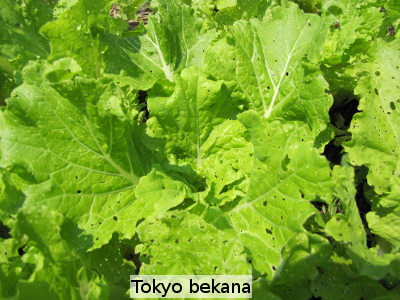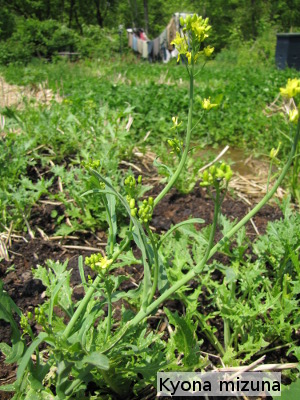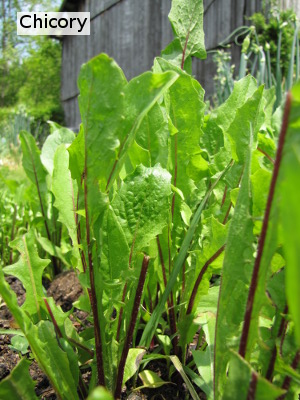
Choosing the best leafy greens
 Greens
aren't very sexy, so I don't talk about them much. But if you
considered the vegetable side of our diet, I'll bet cooked greens would
make up a quarter of the pie, so I figured it was worth trying out a
few new varieties this year. (As a side note, what I call
"greens" are often referred to in the literature as potherbs. I'm
talking about vegetables we grow to eat as cooked leaves.)
Greens
aren't very sexy, so I don't talk about them much. But if you
considered the vegetable side of our diet, I'll bet cooked greens would
make up a quarter of the pie, so I figured it was worth trying out a
few new varieties this year. (As a side note, what I call
"greens" are often referred to in the literature as potherbs. I'm
talking about vegetables we grow to eat as cooked leaves.)
Before I launch into
what I thought of the newcomers to the garden, I
should probably tell you what our old standbys are. The summer
garden is Swiss chard all the
way --- this is the only green that doesn't bolt and the plant's mild
flavor doesn't need the sweetening effects of frost. Most of the
other greens are in the crucifer family with broccoli and  cabbages,
but swiss chard is just about alone (except for spinach, beets, and
amaranth), so garden rotations are a bit easier with swiss chard in the
mix. To top it all off, this summer green isn't bothered by cabbage worms or flea
beetles, although
last year we did get an infestation of striped blister beetles.
cabbages,
but swiss chard is just about alone (except for spinach, beets, and
amaranth), so garden rotations are a bit easier with swiss chard in the
mix. To top it all off, this summer green isn't bothered by cabbage worms or flea
beetles, although
last year we did get an infestation of striped blister beetles.
Our favorite fall and
winter green is kale.
After a frost, kale becomes so sweet that we eat it like candy, and the
plant is also our most cold hardy green, sometimes managing to
overwinter without protection in zone 6. That said, I usually
hedge my bets in the fall by also planting mustard.
The flavor of mustard isn't anything to write home about, but the
plants
love our weather and grow like crazy when nothing else will.
And mustard is a local staple, so you can get the seeds cheap at the
feed
store.
Everyone seemed to be
singing the praises of Asian
greens
last year, though, so I thought I'd better jump on the bandwagon.
On the recommendation of one of Elliot
Coleman's books, I
planted tokyo
bekana and kyona mizuna in early March hoping that these would turn
into good additions to our summer garden. The kyona mizuna is a
bit of a wash --- the leaves are thick and not very tasty, in my
opinion, and the flea beetles love them. On the other hand, Mark
and I both adore the flavor of the tokyo bekana (although the flea
beetles do too.) But I'm a bit disappointed to see that both of
these Asian greens are already starting to bolt (especially the kyona
mizuna) --- I guess they won't
be summer greens after all.
 Meanwhile, I sprinkled chicory
(aka Italian Dandelion) seeds on expansions
of various tree mounds
in
the forest garden. The goal was to come up with a cultivated
perennnial green that likes partial shade and will give us tasty
dinners early in spring when annuals aren't growing. I couldn't
find any chicory specifically labelled as a perennial so this
experiment
may fail in the long run, but in the short run I'm thrilled with the
results. The Catalogna Special Italian Dandelion I planted in
early March was big enough for frequent small cuttings starting at
about
six weeks old and I've found that adding 10% chicory to a pot of other
greens adds complexity to the dish's flavor. (In earlier spring,
the leaves should be less bitter and edible on their own.)
Meanwhile, I sprinkled chicory
(aka Italian Dandelion) seeds on expansions
of various tree mounds
in
the forest garden. The goal was to come up with a cultivated
perennnial green that likes partial shade and will give us tasty
dinners early in spring when annuals aren't growing. I couldn't
find any chicory specifically labelled as a perennial so this
experiment
may fail in the long run, but in the short run I'm thrilled with the
results. The Catalogna Special Italian Dandelion I planted in
early March was big enough for frequent small cuttings starting at
about
six weeks old and I've found that adding 10% chicory to a pot of other
greens adds complexity to the dish's flavor. (In earlier spring,
the leaves should be less bitter and edible on their own.)
Coming up next in 2011's
great greens trial are a variety of amaranth
grown for summer greens and tatsoi (another Asian green) in the
fall. I also plan to experiment with several new varieties of
kale to see if I can find one that's even tastier (inconceivable!) and
more winter hardy. I'd be curious to hear which greens are your
standbys and
why.
Want more in-depth information? Browse through our books.
Or explore more posts by date or by subject.
About us: Anna Hess and Mark Hamilton spent over a decade living self-sufficiently in the mountains of Virginia before moving north to start over from scratch in the foothills of Ohio. They've experimented with permaculture, no-till gardening, trailersteading, home-based microbusinesses and much more, writing about their adventures in both blogs and books.
Want to be notified when new comments are posted on this page? Click on the RSS button after you add a comment to subscribe to the comment feed, or simply check the box beside "email replies to me" while writing your comment.

I really enjoyed collards last year and I love the way the hybrids look in the garden, with a kind of smoky blue/gray color instead of bright green. The young leaves are so tender and tasty and great to add to soups and steeped or steamed for just a minute or two. We've relied on collard greens for two years in a row now, and besides experimenting with new varieties, I think we will plan to continue growing them in the future.
Another plant I love, when it does well, is the swiss chard. Planted it for fall the first year without such great results, because by then the pests were so bad that they were all eaten up and didn't get a chance to grow. Some came up the following spring (from the originaly planting) and grew into nice big plants that were very tasty. With our heat they tend to wilt pretty badly in the sun and after a certain point in the summer they just don't seem to recover, although that is only one year's experience (and I wasn't as attentive as I plan to be in the future).
We have also had a lot of success with lettuce over the winter. We started with a mesclun mix and I found a few species in there that I liked in particular. This fall I am going to start with some new seed for romain. I am also going to experiment with chinese cabbage and an interesting herb called Salad Burnet that is said to taste like fresh cucumbers. We have a lot of dense patches of wild violets, but their tiny leaves make them difficult to collect in large numbers so I usually just add the leaves and flowers to salads with other greens as the main ingredient. I can't think of any other greens I use, but sometimes I do enjoy more potent herbs like parsley for certain types of salads-- tabouleh, egg salad, etc.
Some summer greens I have considered are malabar spinach and new zealand spinach. I haven't tried either of them yet, but I have a friend who grows malabar spinach and the seeds are easy to save. I've also tried amaranth, but not with much luck and the leaves always taste bitter to me.
I planted a partial row of "mixed greens" last year which did all right, nothing spectacular. I think one of those seeds overwintered, but I can't identify it and I don't want to eat it if it's a weed. It's quite large now and the leaf is purple/burgundy. It's not chard, and my garden center guru doesn't know what it is. Any ideas? I'm going to post a photo on Facebook, if you know what it is, you can comment there.
We like beet greens the best, followed by kale which I've had very little luck cultivating here. I think I'm planting it too early, and will try a later crop this year.
Daddy --- my two least favorites. Maybe that's why I didn't like greens growing up?
Sara --- Your swiss chard might do better with some heavy mulch, but it's also possible that it can't cope with the really deep South. People around here don't grow it much, though I'm not sure why since it thrives for us.
I didn't mention salad greens because they're in another category for me. I tend to focus on leaf lettuce there --- black-seeded simpson does the best for us. The mesclun mixes can be delicious, but the seeds are just too expensive. I don't think of it them actual salads, but we use parsley and egyptian onions extensively in our egg and tuna salads.
I've read about malabar spinach and new zealand spinach and will probably try them someday. I've never had much luck with "real" spinach, though, which holds me back. Spinach seems to grow slowly for us and then suddenly bolt. Sounds like I should prepare to be disappointed with leaf amaranth!
Debbi --- I'd be glad to look at your photo on facebook --- just put it on Walden Effect's wall or tag us somehow. People ask me this question all the time, though, and my answer is usually "well, where are your records of what was included in that mixed greens packet?" Good records go a long way!
Sounds like your greens tastes are similar to ours, since beet greens are very close to swiss chard. I hope you have better luck with your kale this year!